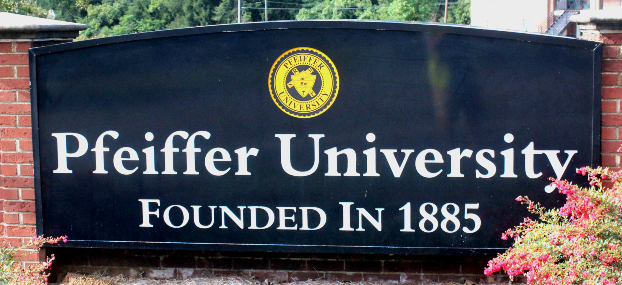Thompson leads conversation on Pfeiffer’s role in integration
Published 9:52 am Friday, January 29, 2021

- Misenheimer, North Carolina
|
Getting your Trinity Audio player ready...
|
On Jan. 18, the multifaceted events marking Martin Luther King Jr. Day at Pfeiffer University began with Dr. Michael Thompson engaging students in two “deep dive” conversations about the history of integration at Pfeiffer.
The conversations each followed a screening of “Citizen King,” a PBS documentary about Martin Luther King Jr., in Henry Pfeiffer Chapel on Pfeiffer’s Misenheimer campus.
Thompson, a professor of history at Pfeiffer University, became its interim provost and vice president for academic affairs last year. He is a longtime scholar on the American South, race relations and civil rights. Some of his most memorable research has focused on the history of integration at Pfeiffer University, particularly the role that Aline Noel played in it.
Noel (1921-1993) enrolled at Pfeiffer College as a junior in 1958, becoming the first African-American student to attend an all-white, four-year church-related school in North Carolina. A quiet-but-courageous admissions decision by Dr. J. Lem Stokes II was ground-breaking. Stokes (1908-2006) served as the president of Pfeiffer College from 1953 to 1968. Noel was the wife of Dr. Essex Noel III, a doctor who practiced for a time in Albemarle. The couple had four sons.
Before her time at Pfeiffer, Mrs. Noel had earned two years of credits during stints at the University of Cincinnati, Fisk University and North Carolina A&T University. She graduated Pfeiffer in 1960 with a bachelor’s degree in business education.
Thompson began working at Pfeiffer in 2000. Since then, talks on integration at Pfeiffer have become his trademark, particularly for students in the Pfeiffer history classes he taught before becoming provost. He has also written two pieces on the subject. The first, from 2003, consisted of prepared remarks he delivered to Pfeiffer’s Board of Trustees at the invitation of Dr. Charles Ambrose, Pfeiffer’s president at the time. The second writing, an edited version of the original remarks, appeared in the summer 2008 edition of Pfeiffer University Magazine, which commemorated 50 years of integration at Pfeiffer.
In an interview with The Falcon Connection, Pfeiffer’s alumni newsletter, before the University’s MLK Day events this year, Thompson talked about what Noel breaking the color line at Pfeiffer meant when it happened, and what it means now.
Dr. Thompson, thank you for granting us an interview. What accounts for your longtime interest in Pfeiffer’s historic role in integrating institutions of higher learning in the South?
Noel’s enrolling at Pfeiffer marked an important first. Also, when I arrived at Pfeiffer, I discovered that its archives had a rather sizeable holding of the reactions to Mrs. Noel’s enrolling at Pfeiffer in letters sent to the university at that time. Dr. Stokes, whom you could probably mark as one of the most important institutional leaders we’ve had at Pfeiffer, saved all the correspondence. He also wrote back to everyone for whom he had a return address.
What does the correspondence suggest to you?
There was an expected large percentage of fiery, hate-filled responses to Stokes’ decision to admit Mrs. Noel. This is reflective of the spirit of massive resistance to school integration at the time. There did exist a surprising degree of support and curiosity (for example, some other church-related schools, including Wake Forest University and Duke University, looked to Pfeiffer for guidance on how to do something similar). I found that fascinating, and it informed the pieces I eventually wrote.
Obviously, there’s been progress in race relations, but there continue to be numerous reminders of how far we still need to go. How would you relate Noel’s story to the horrific scenes of George Floyd’s death we witnessed this past summer?
I don’t know how to answer the question, and I don’t know that I’m the right person, in terms of personal experience, to answer it fairly. I will say this, and it’s often something I tell my students: For me, one of the most significant purposes we have for studying history, particularly around issues of race relations, is to gain a degree of empathy for the group we’re studying.
In the case of Aline Noel, if you look at Lem Stokes’ words or those of Mary Fisher Floyd, a professor of religion who emerged as another leader at Pfeiffer at that time, there seemed to be a great deal of empathy for this student. Unfortunately, in the case of George Floyd, Breonna Taylor and so many others, that kind of empathy wasn’t there until it was too late.
What accounts for Stokes’ empathy?
I think it stems from a religious worldview he developed as a child of missionary parents. (Stokes was born in Wŏnsan, Kangwŏn Province, in what is now North Korea, where his parents, Marion and Pauline, served as Methodist missionaries.) He was an exceedingly empathetic person, and this was reflected in the way he came to understand his responsibilities as a Christian.
You’ve studied this chapter of Pfeiffer history in great detail. What remains for you to discover?
I also think it’s important to look at the lens of Aline Noel. Unfortunately, she passed away long before I could ever have a conversation with her. What we don’t know is her motivation. Finding out more about that, perhaps from her children or other people who knew her, remains an interest of mine.
You’ve talked about the history of integration at Pfeiffer many times to groups of students. In general, how do they react when they hear the story of Aline Noel?
The students like finding out that their university was a barrier-breaker, especially since most of them view school integration as a given. A lot of times they’re surprised and prideful that their school was once showcasing that integration not only should be done but that it could be done.
I hear you begin each talk on Pfeiffer’s role in integration by showing students an undated copy of a brief newspaper report on Ms. Noel enrolling at the school.
Yes, that report ran in Pfeiffer’s newspaper. During my talk it becomes a way for students to think critically and to infer meanings. What do we know based on the evidence that is there in the clipping? In time, they begin to tease out that Mrs. Noel was a married student; that she was at Pfeiffer to finish up her education; that she likely didn’t need housing. Then, I start to get them to think about the reaction to her enrolling at the school, given that this is 1958 and there’s a lot of racial tension around the country and particularly in counties close to Pfeiffer.
That’s when I’ll read some of those letters and read some of Stokes’ justifications. It becomes a useful exercise in understanding one aspect of the civil rights movement.
How have you come to understand Pfeiffer’s role in that movement?
The successes of the civil rights movement were based largely on ordinary people doing extraordinary things.
Ken Keuffel, who authored this article, has served as Pfeiffer’s Assistant Director of Communications since December 2019. He welcomes story ideas from Pfeiffer’s faculty, staff, students, alumni, and friends. The form for submitting story ideas is at www.pfeiffer.edu/newsform.




